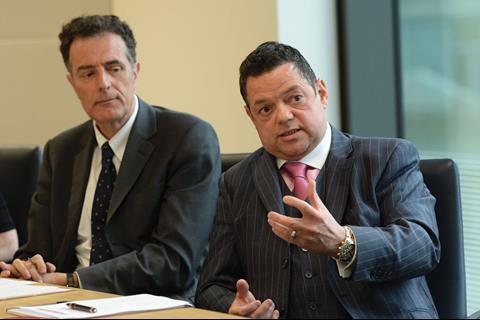Abolishing the single renewal date helped soften the market for PII, the Gazette’s latest roundtable heard. But a casual approach to risk appraisal and due diligence suggests law firms are storing up trouble.
A roundtable on professional indemnity insurance lasting 90 minutes? What would we find to talk about?
Law Society research published in April showed that the last renewal round was silky-smooth in a market that remained soft for the vast majority surveyed. Over three-quarters of 1-25 partner firms found the renewal process easier. Nine out of 10 were satisfied with the way their insurer handled claims. There was plenty of rated capacity. And perhaps most importantly, premiums fell by an average of 8%.
In a practising environment where stability has gone the way of lawyer-lord chancellors, however, the solicitor’s life is rarely straightforward. Live topics this year included the growing threat of cyberscammers, what to do about run-off cover (again) and the Solicitors Regulation Authority’s intention to resurrect proposals for far-reaching reform of the market affecting minimum terms and conditions (MTCs).
It did not take long for a consensus to emerge among those around the table that 2016/17 is again set to be benign. One contributing factor is abolition of the single renewal date in 2013, suggests Neil Ross, head of Axis Pro at insurer Axis Specialty Europe. Chancery Lane’s survey found that one-third of firms have abandoned the traditional common deadline of 1 October.
‘We’re getting to the point where the bottleneck is starting to ease and insurers are able to deal with volume more quickly and efficiently,’ he says.
Broker Richard Brown of Miller Insurance Services works closely with Axis and handles 1,200 solicitor firms. He adds: ‘We saw quite a lot of firms move to 18 months and 60%-70% are electing to take a further 18 – even though that brings them back to 1 October! They are taking advantage of benign conditions, but also the opportunity not to have to fill out a proposal form so frequently. We’re going to see two-year policies coming in, too.’
Francis Dingwall, of compliance advisers Legal Risk, reflects that one perceived benefit of a single renewal date was that it enhanced the profession’s ‘bulk-buying’ power. But Christina Blacklaws, chief operating officer at regional firm Cripps, interjects: ‘The reason we went for 18 months is that we got a better deal.’
Jeremy Riley, head of the professional indemnity team at Kennedys and head of the PI sector focus team at the Forum of Insurance Lawyers (FOIL), also cuts costs this way. ‘An 18-month policy gave us a substantial saving. It’s far better to have the choice,’ he says.
Riley goes on to reflect that differentiating oneself in the market ‘must be difficult for brokers and underwriters’. That is because ‘almost everyone is selling the same product, because of the minimum terms and conditions’. He adds: ‘The only real distinctions we see as a purchaser are the risk of the insurer going under and the after-sales depending on which broker you go to.’
That serves as Crispin Passmore’s cue in his capacity as executive director at the SRA responsible for the regulator’s forthcoming proposals on reforming PII: ‘You say you can’t compete because the minimum terms are so prescriptive. And of course you don’t really want to compete on price – who does? So you compete on relationships to justify the higher price.
‘That raises the question of whether the MTCs are actually right – or whether we should be trying to encourage a market so you can compete on breadth. Taking away a lot of that prescription would allow you to assess the risk on the cover you wanted to offer to different firms in different ways. So we would get a more targeted insurance market and more competition.’
The SRA has travelled this road before, of course – and it turned out to be a cul-de-sac. In late-2014 oversight regulator the Legal Services Board rebuffed its plan to cut to £500,000 the mandatory minimum cover of £2m (£3m for incorporated firms and LLPs). The proposal had been roundly criticised by the Law Society, Legal Services Consumer Panel and mortgage lenders.
The LSB did not believe the SRA had shown enough evidence of the benefits of such a change – but left open the option to make another application.
‘Insurers around the table will know that we have been collecting and analysing 10 years’ worth of claims data,’ Passmore adds. ‘If the numbers support it – and I think they will – that will lead us to make some [further reform] proposals later this year. What we want to do is make sure our minimum terms and conditions are focused on the right risks, rather than on every possible risk that could ever be realised. You know, it’s not about trying to insure a catastrophe. That would be a firm’s choice beyond the core [obligation] to protect consumers.’
High-profile ‘market disrupter’ Trevor Howarth has strong views on where the real risks and barriers to innovation lie. Formerly legal chief at Stobart Barristers, Howarth is now CEO of One Legal, which recently acquired London criminal firm Kaim Todner.
‘We have been talking about the [PII] premium, but what’s really strangling the market is the cost of run-off,’ Howarth says. ‘That is preventing consolidation because a number of practices simply can’t afford four times the premium for a small to medium-sized practice. They are on the roundabout and can’t get off. But when you look at the criminal market, what likelihood is there of a claim coming three or four years after a firm closes? Yet the firms are still having to buy that cover.’
Professional negligence specialist Marlene Henderson, a partner at Browne Jacobson in Nottingham, is not so sure. ‘If someone is detained in prison as the practice ends and serves four years, he is not going to make the claim until he’s released. So you could see a risk for wrongful imprisonment, for example, because someone has lost their job and their house.’
The SRA’s Passmore responds: ‘We’re lucky we’ve now got the data to see how often that happens, so [we can] determine the balance between cost and consumer protection. I could design a system of regulation where every single consumer that gets to a lawyer is guaranteed good-quality service and if an accident happens they’re protected. [But] none of you – let alone people out there in the wider world – will be able to afford solicitors.’
In a discussion paper last year, the SRA proposed reducing run-off cover from six to three years and a ‘hardship fund’ for smaller firms deterred from closing by the cost of maintaining premiums.
So what do the SRA’s 10 years of claims data show? Passmore cannot yet disclose full details, but adds: ‘You can guess where the risks are – where the payments are. The payments are where client money is held. It’s conveyancing; it’s other property; it’s wills and probate. But the payments aren’t as large as people would expect.
‘For me it’s about coming back as a regulator to think about why [insurance] is there at all. It’s there to protect consumers, not lawyers. That’s why it is a regulatory requirement. But we’ve got a one-size-fits-all approach that requires the same assurance, whether you’re delivering a service to HSBC or to one of Trevor’s criminal clients. It’s almost, by definition, wrong for every client.’
The SRA is not alone in revisiting PII. Niche regulator the Council for Licensed Conveyancers is consulting on moving from a master policy to an open market with minimum terms and conditions set out in a participating insurers’ agreement, including – for the first time – run-off cover for a period of six years. The Law Society has warned of a ‘significant risk’ in SRA firms wishing to close switching to CLC regulation in order to avoid the SRA run-off premium.
Passmore describes the plans as ‘very dangerous’, adding: ‘The firms most likely to close get the benefit and the firms that won’t close – and it isn’t foreseeable that they will close – will pay an additional amount in their premiums for it.
‘I’m trying to create a competitive market. I want to unwind cost subsidies.’
At the table
Francis Dingwall Legal Risk; Trevor Howarth One Legal; Crispin Passmore SRA; Charles Hawtin Chancery Pii; Richard Brown Miller; Christina Blacklaws Cripps; PJ Kirby QC Hardwicke; Eduardo Reyes Law Society Gazette; Marlene Henderson Browne Jacobson; Andrew Quick Stevens & Bolton; Jeremy Riley Kennedys; Laura Devine Laura Devine Solicitors; Paul Castellani RPC; Neil Ross Axis; Jon Screech Miller
Expanding on the question of what now constitutes risk, the roundtable turns to the growing threat posed by cybercrime and how this will further shape the market. Research published in April by QBE, which insures more than one in 10 law firms in England and Wales, showed that cybercriminals stole around £85m across the legal market in the previous 18 months. Media attention has focused on ‘Friday afternoon fraud’ attempts, where con artists pose as lenders or clients over the phone. But criminals are just as likely to hack into firms’ IT systems to steal monies passing between solicitors and their clients in conveyancing transactions.
The nature of how a business risk is assessed may therefore move away from what a law firm provides (conveyancing, wills) to how it provides it – including what security and IT systems are deployed.
‘I think this affects every law firm as we move to paper-free or paper-light offices,’ Marlene Henderson says. ‘There is also more agile and home working, so you’ve got a data protection problem if someone leaves a laptop on a train. And law firms need robust prevention measures to prevent hacking.’
Henderson believes that larger firms, where people are not as well (or at all) acquainted with their colleagues could be more at risk: ‘In a two-partner firm, they will sign all the cheques. They know each other.’
Kennedys’ Riley stresses that much of what might generously be tagged ‘cybercrime’ is in fact pretty low-tech. ‘Often these people are no more sophisticated than what we used to call “conmen”,’ he says. ‘The difference is they are able to manipulate electronic media in new ways. Yes, that can affect a bigger firm more because there’s less personal contact. But where the smaller firms are vulnerable is in meeting the cost of putting in proper IT to fight off the high-tech threat.’
In terms of insurance cover, PJ Kirby QC of Hardwicke Chambers and Francis Dingwall both point to the importance of training. ‘It’s what you do as an individual,’ says Kirby, a former solicitor. ‘You can’t just say “we’ll leave that to IT”.’
Dingwall adds: ‘Training has become a very important factor on the insurance side. Where there is an obvious scam and a lot of money is taken, insurers are refusing to pay the claim. They say “you were reckless to the point of dishonesty in paying a round sum to a third party”. Everybody should now have an awareness of what these scams are.’
Even that might not be enough, however, notes Paul Castellani, a solicitor-advocate at RPC who specialises in defending professionals. ‘For corporate departments in larger firms working on listed matters, the risk is that there’ll be an invasive attempt to obtain price-sensitive information, imperilling an IPO or whatever. But there might also be a disgruntled employee who decides to do a Panama Papers-style leak because they don’t like what a firm is doing from a moral perspective. Now that’s something I don’t think you can underwrite.’
Insurance products have emerged specifically to cover cyber risks, Blacklaws observes, adding: ‘The problem there is potentially one of duplication. It’s very difficult to package as distinct from what you are insured for more generally. So if you had an attack and a loss, there might be some unseemly dispute between the insurers about who’s going to cover it.’
Miller’s Richard Brown has encountered only limited interest among solicitors in cyber-liability policies. ‘I think that’s because the main element of cover – your client’s money – is in theory covered under the professional indemnity policy, so the other stuff is kind of peripheral. But some firms are buying it and more are looking at it,’ he says.
‘Interestingly, I had a meeting with a firm yesterday and they were most interested in the “ransom” element [malicious software that infects a computer and restricts users’ access until a ransom is paid to unlock it] and business interruption.’
For the SRA’s Passmore, the principal imperative should not be to insure against cybercrime but to try and stop it happening. ‘Isn’t it remarkable,’ he asserts, ‘that there are still law firms without encrypted data moving money around on the strength of an email, without any follow-up? At what point do insurers say they’ll only insure you if you have a [certain level of protection] in place? If you live in a high-crime area you’ve got to have locks on your windows. It’s not OK to leave your front door open and £50 on the doorstep.’
Cripps’ Blacklaws, who will become deputy vice-president of the Law Society next month, notes the efforts that Chancery Lane has made to educate the profession about cybercrime.
She stresses: ‘We shouldn’t be looking to blame solicitors. All firms need to operate within the budget that their part of the market allows. My worry is that this will become so prevalent it could really inhibit practice, even to the point that some firms have to come out of the market because they can no longer afford to operate.’
As Dingwall observes, ‘that could be a driver for more mergers where small firms cannot afford sophisticated IT systems’.
Asked if the regulator might consider minimum standards on encryption, Passmore says he ‘wouldn’t rule it out’. But he would prefer to rely on market solutions. ‘We need to encourage consumers to ask the right questions,’ he argues: ‘“What insurance have you got?”, “How are you going to look after my money?”, “Will you move my house deposit away from the client account on a whim, or will you wait for some confirmation, either a secure email or phone call?” New regulations are the last thing we should apply.
‘Competition is what drives this sort of stuff,’ he adds. ‘If you free up the insurance market so that you can price on real risk and offer different levels of cover, you can offer more cover to people that have got better security. If we can get that right, then you drive people out of the market that haven’t got adequate protection.’
From navigating hazardous cyber terrain that is being charted day by day, the roundtable turns to more mundane territory. Too many solicitors still do not fill the forms in properly.
One attendee recalls the occasion when he rejected a proposal form because the solicitor had entered in a box: ‘That is a ridiculous question, I am not going to answer it.’ Cover was declined.
As Neil Ross of Axis comments, ‘you’ve only got one chance to make a first impression’.
He adds: ‘When you get a scribbled scrawl of a form that’s half-completed and it’s clear no time been spent on it, you’re halfway there [to making a decision], aren’t you? When you get something that’s been well presented, with a nice cover letter, and that tries to introduce you to the practice, it’s a much more pleasant experience for the underwriter. Obviously the actual content is important. But as far as presenting the risk is concerned, it’s just common sense, isn’t it?’
Kennedy’s Jeremy Riley agrees.
‘It surprises me how little time is invested by some law firms in preparing proposal forms. Its usually their third-largest fixed cost each year. You’ve got your staff and your accommodation, and then you’ve often got very heavy PII premiums. That’s where having a very good insurance broker can work for you. They can take you through the underwriting process and what the insurers want, and then during the course of the year you can gather the information and deliver it to the broker to present to the market. I say this when speaking from a large law firm’s point of view. When you’ve got, say, two partners and you’re under lots of pressure, then it’s not quite so easy to invest the time, but it really is worth that investment to get the proposal process right.’
Charles Hawtin, underwriter at the Law Society’s managing general agency Chancery Pii, notes that an often dilatory approach to renewals is reflected in the Society’s research. ‘You reap what you sow, as the old adage says. I was shocked that 63% of firms only approach one broker, 52% only fill in one form, and 78% of 2-4 partner firms get only one quote because the broker is tied to a particular market and it’s a one-stop shop.’
Affordable cover may be relatively easy to come by at present, but Miller’s Brown fears that the profession could be storing up problems that will materialise in tougher times. No one is ‘fixing the roof while the sun is shining’, as he puts it.
‘This is driven in part by the insurance industry,’ he contends. ‘It’s become too easy for you not to have to try too hard. That’s fine in a soft market, but if and when the market changes the firms that have taken risk seriously and presented it well are going to do better in the long-term.
‘What concerns me is that we [must] avoid another boom-bust repeat of the insurance cycle in five or six years’ time, or whenever. We’ve been doing seminars on professional indemnity insurance since 2000 and now is the time everybody should be coming along to “think risk management” – but we’re having to cancel them.’
Brown concludes our roundtable with a piece of advice: ‘I don’t think enough firms spend time finding out how to approach the market in the most appropriate way. What is not clear to the profession as a whole is that there is no one broker that can access all the various insurers. You need to understand how that works and be able to plot your way through the relationships between them. There’s a very good guide on how to do this on the Law Society website.’
This roundtable was kindly sponsored by Chancery Pii
- For the Law Society’s latest PII guidance see tinyurl.com/oqy4rv5.


































No comments yet